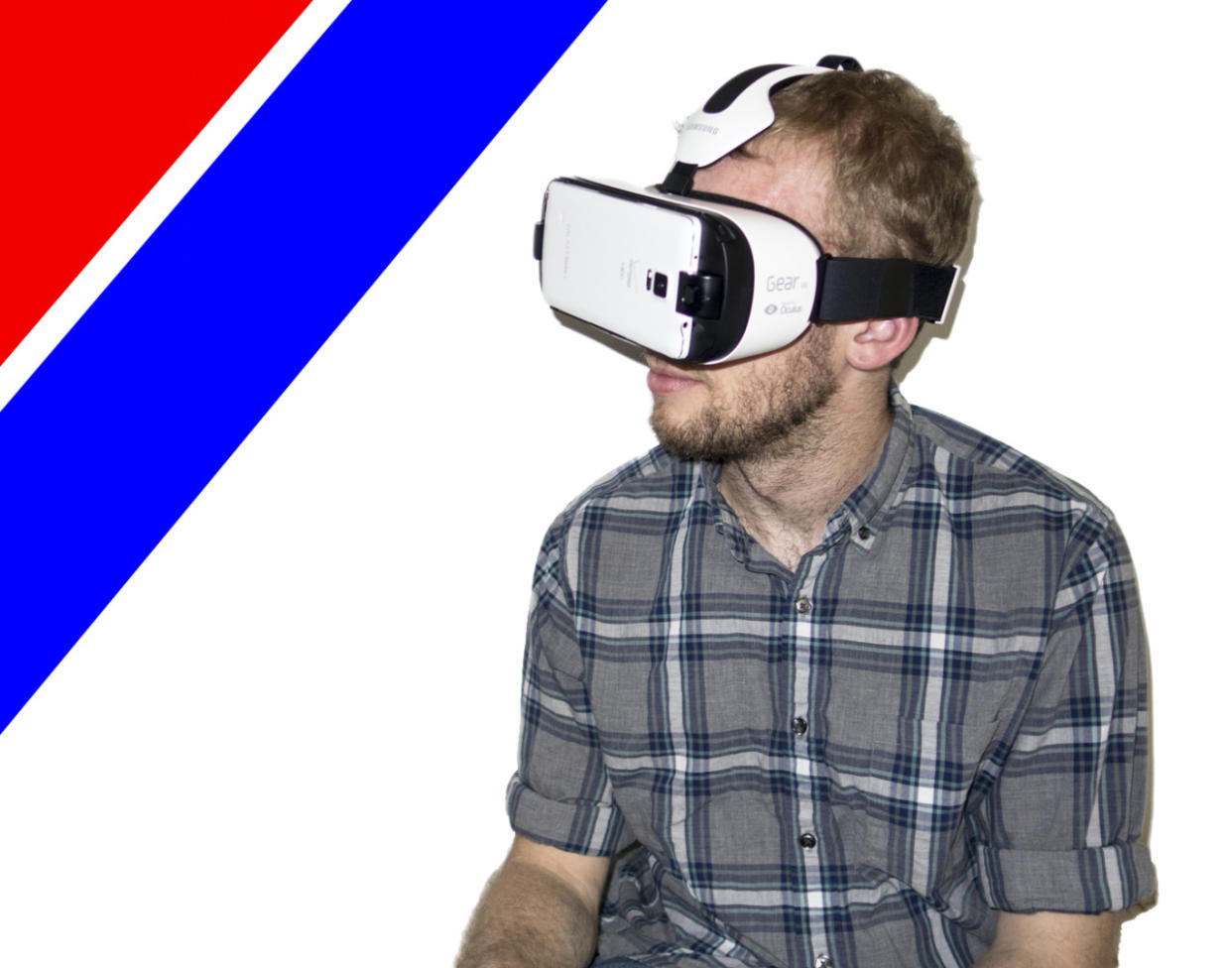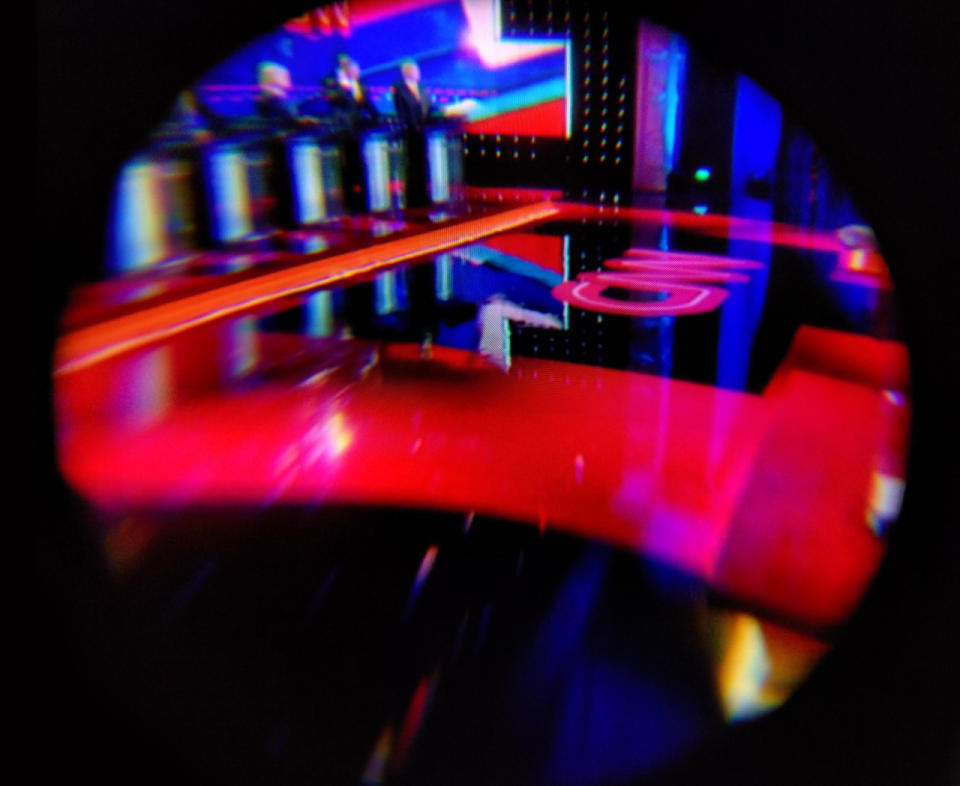Watching a Presidential Debate in VR: It’s Not Just the Political Spin That’ll Make You Dizzy

Daniel Bean/Yahoo Tech
Unlike some of my Yahoo News colleagues, I was not invited to attend Tuesday’s Democratic presidential debate in Las Vegas. Of course, I am fortunate to be alive in the great year of 2015, in which noncredentialed people like me can stream important live events like these over the Internet and onto our VR headsets — you know, virtually transport ourselves there.
(Didn’t Al Gore once predict something like this would be possible?)
With a Samsung Gear VR and a Samsung Galaxy Note 4, I took in CNN’s live-stream virtual reality broadcast of the 2016 election’s first Democratic debate. I won’t bore you with the details of how long it took to get my hardware and necessary apps set up ahead of my solo watch party. Just understand that four different companies — Samsung, Oculus, NextVR, and CNN — were collaborating to bring this VR steam live, and I was in communication with almost all of them Tuesday afternoon while trying to troubleshoot. I wasn’t the only one to run into problems, either.
The bottom line: Once CNN’s stream kicked off at 8:30 p.m. ET, I was in, and everything was about as exciting as could be expected!
Politics in virtual reality?
Four virtual reality cameras shot the five-candidate debate, each placed at different corners of the Wynn casino auditorium. With these, the CNN broadcast periodically cycled through different VR perspectives during the debate. There were a few on-stage looks and one from the perspective of the audience, with each camera providing me 180 degrees of virtual space into which I could look up, down, and to the left and right.
At times during the stand-in-place arguing, I found myself exploring the auditorium, drifting off and zoning out the politicking. I saw cameramen scrambling to the left of me and audience members yawning in their seats to the right of me.

Sanders laid down a sweet Bern in support of Hillary. (AP)
The camera next to Anderson Cooper’s standing podium did a great job of letting me see how shiny his shoes and well-fitted his pants were. And my favorite view, the one looking out from behind the candidates and into the audience, gave me a close, back-stage seat for when Bernie patted Hillary on the back after supportively exclaiming, “The American people are sick and tired about hearing about your damn emails.”
READ: Virtual Reality’s Biggest Hurdle: You Have to See It to Believe It
Beyond a few fun moments here and there, however, I found that the real meat and potatoes of the two-and-a-half-hour affair didn’t exactly make for exciting virtual reality. And I certainly didn’t find any reason why it should have to be live-streamed virtual reality.
The VRy bad
First: Even from the perspective of the two closest on-stage cameras, I found it near impossible to make out any of the candidate’s facial expressions during the debate. And from the audience vantage points, it was hard for me to discern which candidate was which.
When Cooper followed up a Bernie Sanders response by asking, “Anybody else on the stage who is not a capitalist?“ I couldn’t read any of the Democrats’ tense looks.
The screen resolution limitations of today’s mobile VR technology mixed with the quality of the live stream I was getting made for a low-detailed picture. Samsung says its newer Gear VR headset (built for the Galaxy S6) does offer a “slightly” better picture.
Bad camera angles for @NextVR_app, I think. I feel like the audience has more detail than candidates. pic.twitter.com/k3Hj5S1wZv
— Ian Hamilton (@hmltn) October 14, 2015
Second: As a techie, the debate VR experience was a fun novelty. But as a political junkie, the lack of information I was able to take in while watching was frustrating. There is a lot of content that you miss out on when you’re immersed in the VR headset; and I’m not just talking about the lower third graphic on the TV that fills you in on the names of the not-Hillary, not-Bernie candidates who are talking.
Most TV viewers today take in events like this with a smartphone or laptop at hand — fact-checking things candidates say, browsing, and posting to Twitter and Facebook throughout, etc.
I found myself taking the headset off every 10 minutes or so, not only because I was getting a little dizzy, but also so I could see social media reactions to what had just happened on the stage too.

My finest effort to bring you inside the Gear VR. (Daniel Bean/Yahoo Tech)
I watched an abridged version of the September Reagan Library GOP debate on the Gear VR Tuesday afternoon. As I’d already seen it a number of times in standard broadcast fashion — and had already absorbed its details — that viewing experience felt more like a satisfying augmentation. You can also think of it like an instant replay in sports: Some of those crazy camera angles they show can help you better understand what happened after a play has taken place, but no one thinks it’s a good idea to watch a whole game live that way.
As for how watching debates in VR might sway voters’ poll numbers, I feel confident saying that your view on whether Hillary Clinton comes across as “crooked” or “relatable” on regular TV is unlikely to change through the lens of virtual reality.
Email me at danbean@yahoo-inc.com. Follow me on Twitter at danielwbean.
For all the hottest tech news and gadget reviews, follow Yahoo Tech on Facebook!

